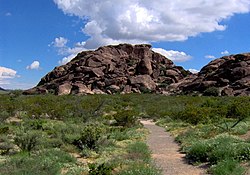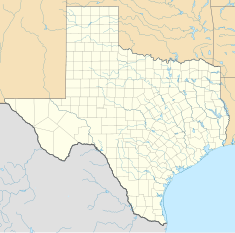Hueco Tanks State Historic Site
|
Hueco Tanks State Historic Site
|
|
 |
|
|
Location of Hueco Tanks in Texas
|
|
| Location | El Paso County, Texas |
|---|---|
| Nearest city | El Paso, Texas |
| Coordinates | 31°55′13″N 106°02′19″W / 31.92028°N 106.03861°WCoordinates: 31°55′13″N 106°02′19″W / 31.92028°N 106.03861°W |
| NRHP Reference # | 71000930 |
| Significant dates | |
| Prehistoric | 1000-1499 AD |
| Historic Aboriginal | 1500-1824 |
| Added to NRHP | July 14, 1971 |
| Designated TSHS | June 12, 1969 |
Hueco Tanks State Historic Site is a Texas historic site in the Hueco Tanks area, approximately 32 miles (51 km) northeast of El Paso, Texas. The park is popular for recreation such as birding and bouldering, and is culturally and spiritually significant to many Native Americans. This significance is partially manifested in the pictographs (rock paintings) that can be found throughout the region, many of which are thousands of years old.
Hueco Tanks State Park & Historic Site was obtained from the county by special deed on June 12, 1969, and by purchase of 121 additional acres on August 10, 1970. This site was opened to the public in May 1970. This 860.3-acre park is named for the large natural rock basins or "huecos" that have furnished a supply of trapped rainwater to dwellers and travelers in this arid region of west Texas for millennia.
The park consists of three syenite (a weak form of granite) mountains. The syenite pluton was formed 34-38 million years ago, as part of a larger range, the Hueco Mountains, which range in age to over 320 million years ago, when this area was covered by an inland sea. The pluton was eventually exposed through weathering to form the rock formations visible today, which jut from the desert floor. The site contains enough water to support live oaks (a specimen is visible in the adjacent image) and junipers, species which survive from the last ice age. Freshwater shrimp and spadefoot toads survive at the site (for this reason, visitors are cautioned against touching the pools of water at Hueco Tanks to avoid destroying the eggs of the animals of the site, for example).
The syenite rock formation is covered with 'desert patina' (visible in the image below), the result of thousands of years of weathering of the rock surface by sun, sand, and water; the site is culturally and spiritually significant to many Native Americans, such as the Mescalero Apache, the Kiowa, the Hopi, and the Pueblo people. This significance is partially manifested in the pictographs (rock paintings) that can be found throughout the region, some of which are thousands of years old. Hueco Tanks contains the single largest concentration of mask paintings by Native Americans in North America, of which hundreds exist at this site.
...
Wikipedia

